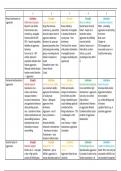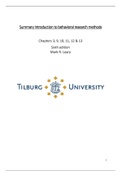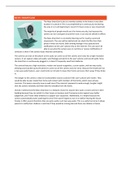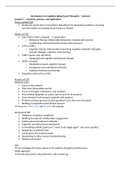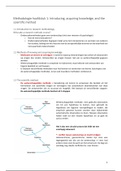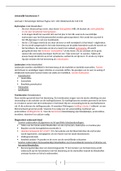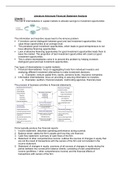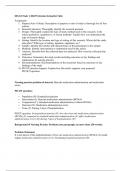1 2 3 4 5
Neural mechanisms in Limitation Strength Strength Strength Limitation
aggression Other brain structures Drugs and serotonin Supporting research Direct or indirect? Correlational evidence
Research: non-limbic Drugs that increase Kluver and Bucy: Neural factors directly Ethics – provoking
brain structures also serotonin e.g. paroxetine destruction of amygdala linked – Gospic et al. aggression not protecting
involved e.g. amygdala found to reduce levels of in monkey dominant in serotonin reduces from harm
function with the OFC aggressive behaviour social group -->lost aggression by inhibiting Brain scans
OFC = impulse regulation, Berman et al.: gave ppt dominance neuronal activity Changes to
inhibition of aggressive placebo/paroxetine, then Mark and Ervin: women Indirect: Denson et al. – OFC/amygdala not
behaviour lab-based game involving with painless stimulation link indirect as other necessarily cause or vv
Coccaro et al. – OFC giving + receiving electric to amygdala become factors e.g. social, Could be intervening
activity reduced in shocks in response to enraged, smashed guitar psychological may affect
psychiatric disorders that insults against wall it
feature aggression Paroxetine: fewer + less
Reduced activity disrupts intense shocks
impulse-control function Causal
--> aggression
Hormonal mechanisms in Strength Limitation Strength Limitation Limitation
aggression Animal research Animal research validity Empirical evidence Dual hormone hypothesis Animal research
Giammanco et al. – Low construct validity – Mehta and Josephs – Carre and Mehta: high Hormones likely similar
review, male rhesus aggression for dominance changes in testosterone testosterone = aggression Aggressive behaviour
macaque monkeys – in social group levels before and after but only a low cortisol more complex
increase in testosterone Mazur – distinguish losing competitive game – High cortisol = e.g. cortisol findings only
and aggressive behaviour aggression from could challenge again/do testosterone’s influence in humans
during mating season, dominance unrelated activity on aggression blocked cognitive factors e.g. in
rats – castration of males Aggression – aim of Rising testosterone – 73% Combined activity actual proactive aggression
reduces testosterone and injury, dominance – re-challenged vs 22% predictor of aggression
mouse-killing behaviour, status falling Reductionist
injecting female rats w Animals artificially Loss of status --> higher
testosterone increase enhanced w testosterone testosterone, aggression
mouse-killing – dominance not injury Correlation
Testosterone – nicer
females to obtain status
Genetic factors in Strength Strength Limitation Limitation Limitation
aggression Research support Support for G x E Precise mechanism Methodological issues Multiple candidate genes
Mertins et al. – male ppts McDermott – ppts w unclear Operationalise aggression Stuart: IPV in men not just
w low + high activity MAOA-L aggressive in Aggression linked to low Convicted of violent crime associated w MAOA-L but
variants of MAOA gene, money allocation expt but serotonin Violent convictions = no also serotonin transporter
, money distributing game only when provoked – MAOA-L gene causes low of violent acts resulting in gene 5-HTT
High – cooperative, fewer otherwise same as activity of MAO-A enzyme conviction – biased Combination most linked
aggressive moves than MAOA-H – should mean higher sample to IPV
low Aggression more likely serotonin but low activity ‘violent’ offenders not Reductionist
interactionist – MAOA-L enzyme does not necessarily most Vassos: meta-analysis, no
and provocation deactivate serotonin, violent/persistent association between
explained by D-S model more for synaptic Complexity of measuring single gene and
transmission aggression – maybe why aggression
MAOA-L: serotonin we haven’t found
disrupted, not heritable component
lower/higher than normal Not representative of all
aggressive people
The ethological Strength Limitation Limitation Limitation Limitation
explanation of aggression Research support Cultural role ignored Ritualistic aggression FAPs not fixed Poor generalisation
Brunner et al. – MAOA-L Nisbett: one type of Goodall: 4-year war, male Outdated, flexible Animals – humans
gene associated w homicide (reactive chimps from one Hunt: influenced by Lorenz and Tinbergen –
aggression in humans aggression) more community killed all environmental factors + behaviour observed in
Twin and adoption: common among white members of another learning experiences birds and fish also typical
genetic aggression males in S states USA group systematically Aggressive FAPs usually of humans
Wilson and Daly: culture of honour in S Victim held down by rival made up of several Aggression must be
adaptive, genetically- Social norm, not chimps while others hit it, behaviours in a series instinctive and innate in
based instinctive, culture can lasting several mins Duration of behaviours humans too
Innate override innate Continued despite varies, even in the same Warfare complex
Genetically determined, appeasement signals individual between
heritable encounters
Cultural differences Better: ‘modal behaviour
pattern’
Evolutionary explanations Strength Limitation Strength Strength Limitation
of human aggression Gender differences Cultural differences Anthropological evidence RWA – bullying Determinism vs free will
Explains why females and In some cultures, Competition with other Bullying due to feeling Evolutionary – biologically
males have different uses aggression almost non- males among ancestors inferior determinist
Maybe due to existent Men have 75% more Address bully’s perceived Survival of ancestors,
socialisation !Kung San people of muscle mass than deficiencies beyond control,
Campbell: not adaptive Africa researched by women, thicker jaw Interventions based on inevitable, not our fault
for female w offspring – anthropologist Thomas – bones, more robust skills this but don’t work Humanism: subject to
put her and child’s ‘Harmless people’ To compete w same-sex Ellis et al. – alt. strategy free will, supported by
survival at risk Negative attitude to rivals – aggression, based on view that research into cultural
Adaptive – verbal aggression – discouraged physical contest, different bullying is adaptive (gain differences
Neural mechanisms in Limitation Strength Strength Strength Limitation
aggression Other brain structures Drugs and serotonin Supporting research Direct or indirect? Correlational evidence
Research: non-limbic Drugs that increase Kluver and Bucy: Neural factors directly Ethics – provoking
brain structures also serotonin e.g. paroxetine destruction of amygdala linked – Gospic et al. aggression not protecting
involved e.g. amygdala found to reduce levels of in monkey dominant in serotonin reduces from harm
function with the OFC aggressive behaviour social group -->lost aggression by inhibiting Brain scans
OFC = impulse regulation, Berman et al.: gave ppt dominance neuronal activity Changes to
inhibition of aggressive placebo/paroxetine, then Mark and Ervin: women Indirect: Denson et al. – OFC/amygdala not
behaviour lab-based game involving with painless stimulation link indirect as other necessarily cause or vv
Coccaro et al. – OFC giving + receiving electric to amygdala become factors e.g. social, Could be intervening
activity reduced in shocks in response to enraged, smashed guitar psychological may affect
psychiatric disorders that insults against wall it
feature aggression Paroxetine: fewer + less
Reduced activity disrupts intense shocks
impulse-control function Causal
--> aggression
Hormonal mechanisms in Strength Limitation Strength Limitation Limitation
aggression Animal research Animal research validity Empirical evidence Dual hormone hypothesis Animal research
Giammanco et al. – Low construct validity – Mehta and Josephs – Carre and Mehta: high Hormones likely similar
review, male rhesus aggression for dominance changes in testosterone testosterone = aggression Aggressive behaviour
macaque monkeys – in social group levels before and after but only a low cortisol more complex
increase in testosterone Mazur – distinguish losing competitive game – High cortisol = e.g. cortisol findings only
and aggressive behaviour aggression from could challenge again/do testosterone’s influence in humans
during mating season, dominance unrelated activity on aggression blocked cognitive factors e.g. in
rats – castration of males Aggression – aim of Rising testosterone – 73% Combined activity actual proactive aggression
reduces testosterone and injury, dominance – re-challenged vs 22% predictor of aggression
mouse-killing behaviour, status falling Reductionist
injecting female rats w Animals artificially Loss of status --> higher
testosterone increase enhanced w testosterone testosterone, aggression
mouse-killing – dominance not injury Correlation
Testosterone – nicer
females to obtain status
Genetic factors in Strength Strength Limitation Limitation Limitation
aggression Research support Support for G x E Precise mechanism Methodological issues Multiple candidate genes
Mertins et al. – male ppts McDermott – ppts w unclear Operationalise aggression Stuart: IPV in men not just
w low + high activity MAOA-L aggressive in Aggression linked to low Convicted of violent crime associated w MAOA-L but
variants of MAOA gene, money allocation expt but serotonin Violent convictions = no also serotonin transporter
, money distributing game only when provoked – MAOA-L gene causes low of violent acts resulting in gene 5-HTT
High – cooperative, fewer otherwise same as activity of MAO-A enzyme conviction – biased Combination most linked
aggressive moves than MAOA-H – should mean higher sample to IPV
low Aggression more likely serotonin but low activity ‘violent’ offenders not Reductionist
interactionist – MAOA-L enzyme does not necessarily most Vassos: meta-analysis, no
and provocation deactivate serotonin, violent/persistent association between
explained by D-S model more for synaptic Complexity of measuring single gene and
transmission aggression – maybe why aggression
MAOA-L: serotonin we haven’t found
disrupted, not heritable component
lower/higher than normal Not representative of all
aggressive people
The ethological Strength Limitation Limitation Limitation Limitation
explanation of aggression Research support Cultural role ignored Ritualistic aggression FAPs not fixed Poor generalisation
Brunner et al. – MAOA-L Nisbett: one type of Goodall: 4-year war, male Outdated, flexible Animals – humans
gene associated w homicide (reactive chimps from one Hunt: influenced by Lorenz and Tinbergen –
aggression in humans aggression) more community killed all environmental factors + behaviour observed in
Twin and adoption: common among white members of another learning experiences birds and fish also typical
genetic aggression males in S states USA group systematically Aggressive FAPs usually of humans
Wilson and Daly: culture of honour in S Victim held down by rival made up of several Aggression must be
adaptive, genetically- Social norm, not chimps while others hit it, behaviours in a series instinctive and innate in
based instinctive, culture can lasting several mins Duration of behaviours humans too
Innate override innate Continued despite varies, even in the same Warfare complex
Genetically determined, appeasement signals individual between
heritable encounters
Cultural differences Better: ‘modal behaviour
pattern’
Evolutionary explanations Strength Limitation Strength Strength Limitation
of human aggression Gender differences Cultural differences Anthropological evidence RWA – bullying Determinism vs free will
Explains why females and In some cultures, Competition with other Bullying due to feeling Evolutionary – biologically
males have different uses aggression almost non- males among ancestors inferior determinist
Maybe due to existent Men have 75% more Address bully’s perceived Survival of ancestors,
socialisation !Kung San people of muscle mass than deficiencies beyond control,
Campbell: not adaptive Africa researched by women, thicker jaw Interventions based on inevitable, not our fault
for female w offspring – anthropologist Thomas – bones, more robust skills this but don’t work Humanism: subject to
put her and child’s ‘Harmless people’ To compete w same-sex Ellis et al. – alt. strategy free will, supported by
survival at risk Negative attitude to rivals – aggression, based on view that research into cultural
Adaptive – verbal aggression – discouraged physical contest, different bullying is adaptive (gain differences


